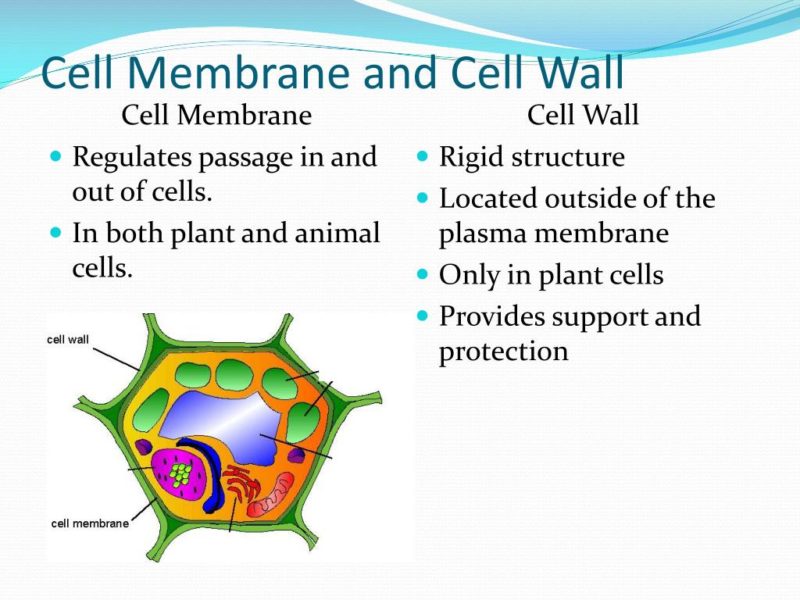What is the difference between cell wall and cell membrane?
A cell comprises of both cell wall and cell membrane. These two structures on a cell tend to play different functions though they sound similar.
The lesson provides the core difference between the cell wall and the cell membrane. Take the time to read through and note the differences either in structure or function.

What Is A Cell Wall?
A cell wall is the outermost layer of a plant cell, a fungal cell, and a bacteria cell. This layer tends to be absent in the plant cell.
The plant cell wall contains cellulose, fungal cell wall contain chitin, and the bacteria cell wall is made up of peptidoglycan.
These structural materials found in the cell wall is the reason behind being tough, flexible, and rigid.
Main Functions of a Cell Wall
- Offer protection to the cell against physical and pathogen damages
- Regulate and control the growth of a cell
- Offer support, strength, and maintenance of the cell shape
- The storage unit of carbohydrate in a cell
- Act as a selectively permeable instrument in a cell
What Is A Cell Membrane?
A cell membrane is also known as the plasma membrane. It is a semi-permeable membrane made up of lipids and proteins. It is the outermost layer of an animal cell.
The main role of the plasma membrane is to control entry molecules inside a cell and it is quite selective in nature. Not all molecules are allowed to pass through it.
Main Functions of a Cell Membrane
- Protecting the integrity of a cell interior
- Provide support and maintenance of the cell shape
- Enhance the balance of endocytosis and exocytosis in cell
- Regulate and control cell growth
- Promote cell signaling and communication
- Allow entry of certain molecule only due to selective permeability
Comparison Chart: Cell Wall vs Cell Membrane
| Basic Terms | Cell Wall | Cell Membrane |
| Definition | The outermost non-living part of a cell that provides a fixed shaped | The outermost living part of a cell that provides shape to the cell. |
| Present | Plant, Algae, Fungi, and Bacteria | Humans, animals, plant, and bacteria |
| Made of | Pectin, chitin, lignin, glycol proteins, glycolipids, sugar, and cellulose. | Lipids, proteins, and carbohydrates |
| Size | 20- 80nm in thickness | 7.5–10 nm in thickness |
| Structure | Tend to be thick and rigid for a fixed shape | Tend to be thin and delicate for change of shape |
| Main Role | Protect the cell from physical and pathogen damages | Protect and maintain the internal environment of the cell. |
| Elasticity | Elastic | Non-elastic |
| Receptors | Absent | Present for signaling and communication |
| Permeability | Complete permeable | Semi-permeable |
| Nutrition | Does not need any nutrition to survive | Need proper nutrition for survival |
| Metabolic function | Non-living and inactive | Living and metabolically active |
Core Difference Between Cell Wall and Cell Membrane
- The cell wall is mainly present in plant cell while the cell membrane is present in the animal cell.
- The cell wall is made of cellulose whereas cell membrane lipids and proteins
- The cell wall is completely permeable while the cell membrane is semi-permeable
- The cell membrane protects the protoplasm and regulates the entry of molecules in a cell whereas cell wall offer protection from external factors
- The plasma membrane is metabolically active and living while cell wall is metabolically inactive and non-living.
- The cell membrane has receptors to enhance communication while cell walls lack receptors.
- The cell membrane is flexible and elastic while the cell wall is rigid and inelastic
Similarities between Cell Wall and Cell Membrane
- Both are cell organelles
- Offer protection to the cell
- Control entry and exit of molecules in a cell
- Provide shape to the cell
- Offer support and rigidity of a cell
You May Also Like:
- Difference between Chordates and Non-Chordates
- Difference between Plant Cell and Animal Cell
- Difference between Chitin and Cellulose
- Difference Between Cell and Tissue
Comparison Video
Conclusion
These two cell organelles are quite vital to cell as far as protection and support is a concern. However, they tend to differ according to their roles and composition. I hope the information has been useful. Use the comment section to share your views and suggestions
More Sources and References
- Cell Wall. Wikipedia
- Cell Membrane. Science Direct